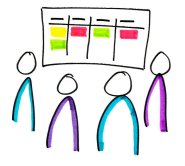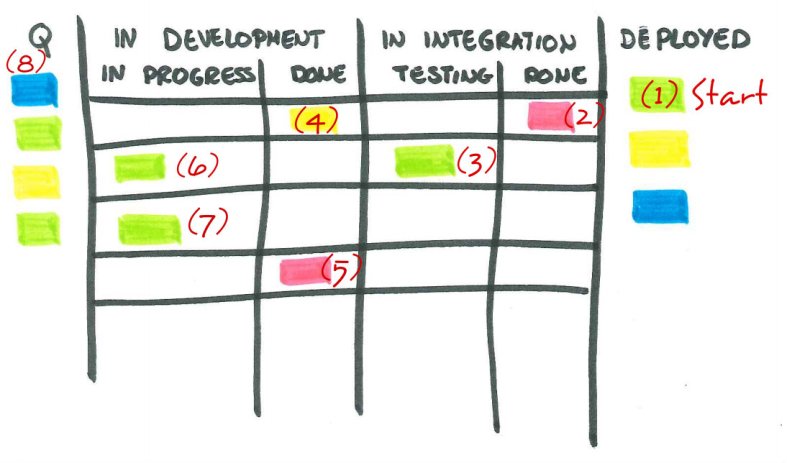Are you tired of long stand ups where people merely report to the Scrum  Master? Do team members list all the ways in which they are busy rather than sharing information with each other?
Master? Do team members list all the ways in which they are busy rather than sharing information with each other?
One technique has helped my recent teams get more focused stand ups: Walk the Board. (Update: @KirstenMinshall pointed out on Twitter that Walk the Wall is catchier )
Instead of having each team member answer the three standard questions (what did I do yesterday? what will I do today? and what am I blocked by?), Walk the Board emphasises the stories which populate the board.
You move through the board story by story, but starting with the ones which are the closest to completion.
You start on the column to right which is usually “Done” or “Deployed” and then move left one step at the time. In each column, move in order of priority until you have talked about all stories.

For us it means that we start talking about the stories which were deployed since last stand up (see (1) in the picture). We then move over to the stories which are waiting to be deployed (where testing is done – (2) in the picture). We ask “what do we need to do to deploy this today?” and make sure that we’ll work towards removing obstacles or doing those tasks.
After that we have the stories which are in testing (3), and we ask “what do we need to do to get testing done today?”
And so on.
After having gone through all the stories, we ask if there is someone who hasn’t spoken in order to identify any work which isn’t on the board.
Benefits
The story and not the individuals are the star of the stand up
Instead of focusing on the individuals and how much work they have achieved, Walk the Board emphasises the goal of the team: getting things done.
We don’t care how busy you were, what’s important to us is real progress.
The story needs to be finished, it doesn’t matter who is working on it.
A team effort instead of individual performance
Again, the objective is to finish those stories and by not asking the individuals what they have done and instead ask the team we reinforce the feeling that we help each other towards our common goal.
Higher level of engagement
The stand up becomes more interesting and I’ve noticed that the level of engagement for everyone is higher. Maybe it’s the shared enthusiasm of collectively getting the stories closer to completion.
Of course, it doesn’t solve everything. If a few team members get caught up in a design discussion, it’s still possible to start dozing off.
Conclusion
Walk the Board is more true to the original purpose of the stand up.
The stand up is a meeting created to help the team. They are not for reporting to anyone but often we end up in stand ups where everyone reports to the Scrum Master.
A symptom of this is when the team doesn’t have stand ups when the Scrum Master is away.
When the team doesn’t use the stand up to report to the Scrum Master and instead finds a value in the meeting, they are less likely to ignore them.
Try out Walk the Board and see if it helps you reinforce team work and get more energy into your stand ups!

 I don’t believe the classic team sizes of 7 (+- 2) people. I feel that those teams are too large to have meaningful conversations.
I don’t believe the classic team sizes of 7 (+- 2) people. I feel that those teams are too large to have meaningful conversations. Book review:
Book review: